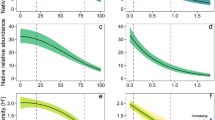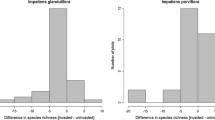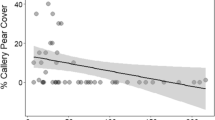Abstract
We briefly reviewed the literature on habitat matching in invading non-native plant species. Then we hypothesized that the richness and cover of native annual and perennial plant species integrate complex local information of vegetation and soils that would help to predict invasion success by similarly adapted non-native plant species. We tested these ‘life-history habitat matching’ relationships in 603 0.1-ha plots, including 294 plots in Colorado, which were relatively high for the cover of native perennial plant species, and for 309 0.1-ha plots in southern Utah, which were relatively high in the cover of native annual plant species. We found strong positive relationships between the richness and foliar cover for both native and non-native species, whether they were annual or perennial species (0.34 > r 2 < 0.53; P < 0.0001). We also found significant positive relationships between the cover of native annual species at a site and the richness (r 2 = 0.13; P < 0.0001) and the foliar cover (r 2 = 0.06; P < 0.0001) of non-native annual species. The proportion of non-native annual species in the flora of a plot also increased significantly with the foliar cover of native annual species. Conversely, the richness and cover of non-native annual species were significantly negatively associated with the foliar cover of native perennial species (r 2 = 0.05 and 0.06, respectively; P < 0.0001). The cover of non-native annual or perennial species was not significantly correlated with soil texture variables, %N, or %C. We conclude that there may be a high degree of life-history habitat matching by non-native annual species in these study sites. Information on native annual and perennial species richness and cover may help characterize the complex soils, climate, and disturbance environment in which similarly adapted non-native plant species establish and gain foliar cover.
Similar content being viewed by others
References
Baker H G 1965 Characteristics and modes of origin of weeds. In The Genetics of Colonizing Species. Eds. H G Baker and G L Stebbins. pp. 147–172. Academic Press, New York.
Barbour M G 1999 Terrestrial Plant Ecology. Benjamin Cummings, Menlo Park, Calif. 1 v. (various pagings) p.
M Bashkin T J Stohlgren Y Otsuki M Lee P Evangelista J Belnap (2003) ArticleTitleSoil characteristics and plant exotic species invasions in the Grand Staircase – Escalante National Monument, Utah, USA Appl. Soil Ecol. 22 67–77 Occurrence Handle10.1016/S0929-1393(02)00108-7
Bazzaz F A, 1986 Life history of colonizing plants: some demographic, genetic, and physiological features. In Ecology of Biological Invasions of North America and Hawaii. Eds. H G Baker, H A Mooney and J A Drake. pp. 96–110. Springer-Verlag, New York.
Begon M, Harper J L and Townsend C R 1996 Ecology: Individuals, Populations, and Communities. Blackwell Science, Oxford, UK; Cambridge, Mass. xii, 1068 pp.
C S Brown K J Rice (2000) ArticleTitleThe mark of zorro: effects of the exotic annual grass Vulpia myuros on California native perennial grasses Restor. Ecol. 8 10–17 Occurrence Handle10.1046/j.1526-100x.2000.80003.x
M J W Burke J P Grime (1996) ArticleTitleAn experimental study of plant community invasibility Ecology 77 776–790
Chapin F S I, Reynolds H L, D’Antonio C M and Eckhart V M 1996 The functional role of species in terrestrial ecosystems. In Global Change and Terrestrial Ecosystems. Eds. B H Walker and W L Steffen. pp. 403–430. Cambridge University Press, New York.
Chong G W 2002 Multi-scale sampling of native and non-native plant diversity: examples of data analyses and applications. In Dept. of Graduate Degree Program in Ecology. Colorado State University, Fort Collins.
G W Chong R M Reich M A Kalkhan T J Stohlgren (2001) ArticleTitleNew approaches for sampling and modeling native and exotic plant species richness West N. Am. Nat. 61 328–335
J D Corbin C M D’Antonio (2004) ArticleTitleCompetition between native perennial and exotic annual grasses: implications for an historical invasion Ecology 85 1273–1283
D’Antonio C M, Dudley T L and Mack M C 1999 Disturbance and biological invasions: direct effects and feedback. In Ecosystems of Disturbed Ground. Ed. L R Walker. pp. 413–452. Elsevier, New York.
Darwin C 1966 On the Origin of the Species. Harvard University Press, Cambridge. xxvii, ix, 502 pp.
A R Dyer K J Rice (1997) ArticleTitleIntraspecific and diffuse competition: the response of Nassella pulchra in a California grassland Ecol. Appl. 7 484–492
Elton C 1958 The Ecology of Invasions by Plants and Animals. Meuthuen and Company, Ltd, London.
J P Grime (1973) ArticleTitleCompetitive exclusion in herbaceous vegetation Nature 242 344–347 Occurrence Handle10.1038/242344a0
J G Hamilton C Holzapfel B E Mahall (1999) ArticleTitleCoexistence and interference between a native perennial grass and non-native annual grasses in California Oecologia 121 518–526 Occurrence Handle10.1007/s004420050958
Harper J L 1977 Population Biology of Plants. Academic Press, London; New York. xxiv, 892 pp.
S Harrison (1999) ArticleTitleLocal, regional diversity in a patchy landscape: native, alien, and endemic herbs on serpentine Ecology 80 70–80
Larcher W 1995 Physiological Plant Ecology: Ecophysiology and Stress Physiology of Functional Groups. Springer-Verlag, New York.
Lee M 2001 Non-native plant invasions in Rocky Mountain National Park: linking species traits and habitat characteristics. In Dept. of Graduate Degree Program in Ecology. pp vi, 41 leaves. Colorado State University, Fort Collins.
J M Levine C D’Antonio (1999) ArticleTitleElton revisited: a review of evidence linking diversity and invasibility Oikos 87 15–26
Mack M C 1989 Temperate grasslands vulnerable to plant invasions: characteristics and consequences. In Biological Invasions: A Global Perspective. Eds. J A Drake, H A Mooney and F DiCastri. pp. 155–179. John Wiley, New York.
M C Mack C M D’Antonio (1998) ArticleTitleImpacts of biological invasions on disturbance regimes Trends Ecol. Evol. 13 195–198 Occurrence Handle10.1016/S0169-5347(97)01286-X
National Climatic Data Center 2003 National Climatic Data Center. Updated: 17 April 2003. Internet. Available: http://www.ncdc.noaa.gov/oa/ncdc.html.
J F Quinn G R Robinson (1987) ArticleTitleThe effects of experimental subdivision on flowering plant diversity in a California annual grassland J. Ecol. 75 837–855
Rejmanek M 1989 Invasibility of plant communities. In Biological Invasions: A Global Perspective. Eds. J A Drake, H A Mooney and F DiCastri. pp. 369–388. John Wiley, New York.
Rejmanek M 1999 Invasive plant species and invasible ecosystems. In Invasive Species and Biodiversity Management. Eds. O T Sandlund, P J Schei and A Viken. pp. 79–102. Kluwer Academic Publishers, Dordrecht.
G R Robinson J F Quinn M L Stanton (1995) ArticleTitleInvasibility of experimental habitat islands in a California winter annual grassland Ecology 76 786–794
Shultz L M 1998 The flora, fauna of the Colorado Plateau: what do we know? In Learning from the Land. Eds. L M Hill and J J Koselak. pp. 203–210. Grand Staircase-Escalante National Monument Science Symposium, Southern Utah University, November 4–5, 1997, 1998.
Sokal R R and Rohlf F J 1995 Biometry: The Principles and Practice of Statistics in Biological Research. W.H. Freeman, New York. xix, 887 pp.
T J Stohlgren (2002) ArticleTitleBeyond theories of plant invasions: lessons from natural landscapes Comm. Theor. Biol. 7 355–379
T J Stohlgren D T Barnett J T Kartesz (2003) ArticleTitleThe rich get richer: patterns of plant invasions in the United States Frontiers in Ecol. Environ. 1 11–14
T J Stohlgren K A Bull Y Otsuki (1998a) ArticleTitleComparison of rangeland vegetation sampling techniques in the central grasslands J. Range Manage. 51 164–172
T J Stohlgren G W Chong M A Kalkhan L D Schell (1997a) ArticleTitleRapid assessment of plant diversity patterns: a methodology for landscapes Environ. Monit. Assess. 48 25–43 Occurrence Handle10.1023/A:1005796618823
T J Stohlgren G W Chong L D Schell K A Rimar Y Otsuki M Lee M A Kalkhan C A Villa (2002) ArticleTitleAssessing vulnerability to invasion by nonnative plant species at multiple spatial scales Environ. Manage. 29 566–577 Occurrence Handle10.1007/s00267-001-0006-2 Occurrence Handle12071506
T J Stohlgren M B Coughenour G W Chong D Binkley M A Kalkhan L D Schell D J Buckley J K Berry (1997b) ArticleTitleLandscape analysis of plant diversity Landscape Ecol. 12 155–170 Occurrence Handle10.1023/A:1007986502230
T J Stohlgren M B Falkner L D Schell (1995) ArticleTitleA modified-Whittaker nested vegetation sampling method Vegetatio 117 113–121 Occurrence Handle10.1007/BF00045503
T J Stohlgren M Lee K A Bull Y Otsuki C A Villa (1998b) ArticleTitleRiparian zones as havens for exotic plant species in the central grasslands Plant Ecol. 138 113–125 Occurrence Handle10.1023/A:1009764909413
T J Stohlgren Y Otsuki C A Villa M Lee J Belnap (2001) ArticleTitlePatterns of plant invasions: a case example in native plant species hotspots and rare habitats Biol. Invas. 3 37–50
T J Stohlgren A J Owen M Lee (2000) ArticleTitleMonitoring shifts in plant diversity in response to climate change: a method for landscapes Biodivers. Conserv. 9 65–86 Occurrence Handle10.1023/A:1008995726486
T J Stohlgren L D Schell K A Bull Y Otsuki G Newman M Bashkin Y Son D Binkley G W Chong M A Kalkhan (1999) ArticleTitleExotic plant species invade hot spots of native plant diversity Ecol. Monogr. 69 25–46
D Tilman (1999) ArticleTitleThe ecological consequences of changes in biodiversity: a search for general principles Ecology 80 1455–1474
USDA NRCS 1998 The PLANTS database (http://plants.usda.gov). National Plant Data Center, Baton Rouge, LA 70874–7790, USA.
S Venevsky I Veneskaia (2003) ArticleTitleLarge-scale energetic and landscape factors of vegetation diversity Ecol. Lett. 6 1004–1016 Occurrence Handle10.1046/j.1461-0248.2003.00527.x
P M Vitousek (1990) ArticleTitleBiological invasions and ecosystem processes: towards an integration of population biology and ecosystem studies Oikos 57 7–13
Weaver J E and Clements F E 1929 Plant Ecology. McGraw-Hill Book Company Inc., New York. xx, 520 incl. front. (map) illus., diagrs. p.
Weber W A and Wittmann R C 1992 Catalog of the Colorado Flora: A Biodiversity Baseline. University Press of Colorado, Niwot, Colo. xi, 215 pp.
Welsh S L 1993 A Utah Flora. Brigham Young University, Provo, Utah, U.S.A. vii, 986 pp.
Author information
Authors and Affiliations
Corresponding author
Rights and permissions
About this article
Cite this article
Stohlgren, T.J., Crosier, C., Chong, G.W. et al. Life-history Habitat Matching in Invading Non-native Plant Species. Plant Soil 277, 7–18 (2005). https://doi.org/10.1007/s11104-005-4893-5
Received:
Accepted:
Issue Date:
DOI: https://doi.org/10.1007/s11104-005-4893-5




